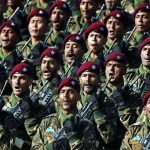Stanly Johny through his work The ISIS Caliphate: From Syria to the Doorsteps of India has presented the origin, formation and the ideology of various Islamic organizations, based on both factual information along with secondary research. The book is divided into two parts, with first part comprising four chapters that deals with the core inspiration behind the terror-brand that ISIS became. The second part consists of two chapters, that highlights how the group expanded their terror to the periphery, launching its brutalities and recruiting youngsters from around the world.
The first chapter highlights how the ISIS, during conflicts in Iraq and Syria, decides to revive a rather medieval concept of having a Caliph, because of which the question of “Who would proclaim the title of a Caliph?” became important. However post Second World War, with growing interference from the US and the Soviet Union, the focus saw a shift towards Pan-Arabism. The author is successful in giving an understanding of why the radical jihadists in 1989 in an attempt to ‘unify’ the Muslim world wanted to create a ‘true Islamic emirates’ and implement Sharia. But they understood that support of the Ummah (the whole community of Muslims) was required if the goal of terror had to be achieved. Therefore, the 1990s saw capturing, recruiting and shifting bases. The Iraq war and chaos that followed made it favorable for a closer relationship between Bin Laden and Abu Musub al-Zarqawi whose life may have been short but his anti-shiism continued to influence the radicalized youth.
In the second chapter, soon after Zarqawi is killed, a wave of puritanical Islamic state spreads across the region and soon after Baghdadi took over to get a Salafi-Jihadist force. One major inference to be drawn from this particular chapter would be that somewhere an experience in the battleground was an advantage when it came to preaching and mobilizing the youth. Also the author has gathered views of Islamic Scholars who in fact were not just members but were inspired by the radical beliefs of the “Brotherhood” regime. Stanly Johny has provided a detailed account of the quest for creating Islamic State of Iraq (Dawlat al-‘Iraq al-Islamiyya), growing resentment among Iraqis Sunnis and the Civil War in Syria providing a good understanding of this section.
In the third chapter, Stanly gives a geopolitical interpretation of the war and addresses the agenda of “leading from behind” by the US. Apart from this, the author does highlight upon the differing ideologies of the Baghdadi and Joulani leadership, where the faction became expansion of the territories for the Islamic State vs overthrowing the government all together. The question whether it was virtue or vice in the Sharia to divide one Mujahid Jammat (jihadist group) into different ranks, became the highlight. The author is successful in capturing the root that held Islam together.
Fourth chapter is a more theoretical definition of Islamic doctrine. From advocating the “why” of holding onto the beliefs because there was a deepening moral crisis among Muslims, to teaching non-reliance on any intercession, this section throws light on lectures by Egyptian Islamic scholar, Muhammad Abduh, who in 1897, countered western values by rejecting them in his work, Risalat-al-tawhid (The Theology of Divine – Unity). Stanly Johny describes details about Wahhabism and Salafi movements ending this section on heavy statements made by the supporters.
Chapter five of the book, if not entirely then at a brim level, touches upon the expansion of Islamic State globally. The first hand research does come handy by Stanly himself meeting with the families of the youth in Kerala who were wooed to join ISIS. However, the book is contradictory when it says ‘ISIS failed to make any inroads in Jammu and Kashmir” when clearly time and again cases have erupted where unfurling black flags disrupted internal politics in Kashmir. The book doesn’t really addresses the fundamental difference between the way armed struggle has been carried out in Kashmir against India and the default ISIS process of using Islamic metaphors and slogans even though the chapter has been titled “The Indian Connection”.
Chapter six, raises a question “Is it over?” and to answer that, the author has presented a crux of the entire book in his last chapter, where he addresses, the Syria conflict, US- Russia attitude in the war, expansion of Taliban, Al-Qaeda, ISIS “as not just an insurgency or terror organization, but also a proto-state”. The Shia-Sunni ideological differences also find a mention here which explains many unanswered- culture related questions.
Conclusion
To call spade a spade, this book fairly covers the journey of a terror organization being brought into existence and ends with a question about its future. The strength of this book is that it has described the modus operandi of ISIS, behind recruiting the youth from all over the world. The major weakness however would be the limited Indian perspective. A separate chapter altogether possibly would have made the reading even more interesting but nonetheless, Stanly Johny has made a decent attempt at presenting his hard work that makes the people in academia and otherwise, crave for more knowledge about the subject. A supplementary reading on a similar topic can be Black Flags: The Rise of ISIS by Joby Warrick that is even more elaborative with the data on the terrorist organizations.














